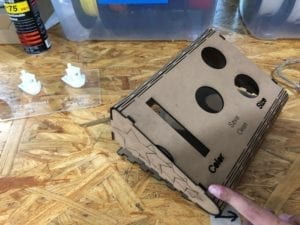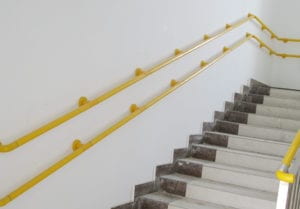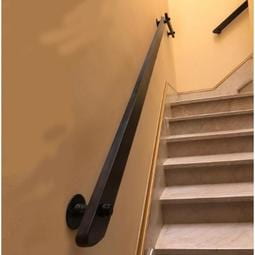Our user test video is here.
Conception and Design
At the very beginning, we would like to make a drawing machine for people with hand disabilities that could not hold a pen. After meeting with Young, he said that we would better focus on a smaller group of people instead of the broad audience of people with hand disabilities. So, we narrowed our scope to people without fingers. Based on this idea, we chose to use the largest buttons we can find in the ER and slide potentiometers instead of knobs to allow users to adjust the color and size of the brush. Such choices may ensure that people without fingers would (ideally) have no difficulty in using our drawing machine. For the part that controls the position of the brush, the original plan was to use a joystick but thanks to Zander’s recommendation, we replaced it with Leap Motion. Although Leap Motion could not compete with the joystick in terms of accuracy. We still think it would be a better choice because the joysticks we found in ER are too small in size, which would not be very friendly to our users.

Another particular design we used, which few people have noticed, is our case for Magic Brush. When presenting out midterm project “Duet Beat”, Professor Marcela said that instead of ordinary boxes with squared shape, maybe we should come up with other designs to illustrate clearly how could the potential users use our project. This suggestion is of great value to us because accessibility and availability are something Guangbo and I have been always pursuing. To integrate this idea into our final project, I found the laser cut template from this webpage. It is originally a box clock but there is a slope on one side. Although this seems to be a very minor design difference than using a box from Makercase, I believe it could better hint the users that they need to press the buttons we provided, especially for children who are not quite tall but may use our project. This design enables them to see the buttons directly if their vision is not as high as the top of an ordinary box.
Fabrication and Production
From my perspective, the biggest success and failure are closely linked with each other in our project. I feel really happy that unlike our midterm project, we have enough time to fully realize our blueprint. Some of the aspects even attained better effects than we thought at the beginning (e.g. the use of Leap Motion instead of joysticks). However, it is very sad for us being unable to invite people with hand disabilities to test whether this project could really assist them in creating art. Although letting Magic Brush educate users about people with hand disabilities is still quite meaningful, to us, it is more like a compromise. The version we prepared for user testing session has a mandatory instruction that takes everyone 20 seconds to read at the beginning, most people did not like this design. Some suggest that we can show instructions under the main canvas so that users can refer to them while they paint. After consideration, we still decided to remove the instructions altogether because in Tom Igoe’s Making Interactive Art: Set the Stage Then Shut Up and Listen, he already said that designers “shouldn’t interpret their own work.” Meanwhile, our biggest concern as designers that people do not know how to interact with Leap Motion has been solved by using a red sticker to identify the brush and a physical wooden frame to identify the canvas. In our final version presented on Tuesday, there is a zone under the canvas used to show information such as “Saved Successfully!” and the painting the user just created. This suggestion comes from Professor Rudi. He said that we would better give users clearer responses after saving. Guangbo and I think this is indeed very important because it can increase the overall accessibility of our project. The responses have the same effect as the small light on our midterm project so the user would not be lost about what the machine is doing. Near the end of the user testing session, we invited Young to use our project, he said that if we insist regarding Magic Brush as something that can help people with accessibility to create artwork, we need to do some further improvements such as modifying the shape of the slide potentiometer. (which we did later by laser cutting a smaller box) He also mentioned that without real users to test, he could not say that Magic Brush is fully capable of helping people with hand disabilities to create art. If that is the case, turning it into an educational project would also be a good idea. Guangbo and I thought about this and have to admit that maybe positioning it as an educational project would be the most practical solution. In the end, for educational purposes, we prepared tapes in order to simulate the scenario to the best extent and added the QR Code function to further raise users’ awareness of people with hand disabilities.
Conclusions
The goal of Magic Brush is to create an educational experience about people with hand disabilities and raise everyone’s awareness on this group of people by letting them experience how difficult it is for disabled people to do some things we think are normal such as painting. This project is in line with our definition of interaction. It has two actors (the user and a computer), there are input (through buttons, potentiometer, and leap motion), processing (through Arduino and Processing) and output (visual and audio outputs). There are clear feedbacks both when the user is drawing or saving his or her work. The big buttons, design of the laser-cut box, adoption of leap motion and other factors revealed our effort of bringing accessibility and availability to everyone. However, to achieve the highest level of accessibility and availability, we should still invite real users with hand disabilities to test our project. Generally speaking, the audience interacted in the way we planned during our user tests. They could carry out the full process of interaction we have designed. If we have more time, we think we may consider the possibility of different brush textures (turning dots into lines, simulate the feeling of painting with a pencil, a pen, a sprayer etc.) Perhaps we will also make some small changes to the design of the box and turn it into a colorful one to identify that this project is used to create art.
I used to think that since Guangbo and I have already gone through so much during midterms, we would not learn as much when making our final project. But of course, this idea is wrong. The process of designing something for people with disabilities helped me to realize how difficult it is to put the idea of “Making user the center of project design” into practice. It is indeed very difficult to design something for a group of people you do not belong to. Even though I think we are already very considerate on each designing details, we are still not confident that Magic Brush could really help people with hand disabilities to paint. Now I have an increasing feeling that in our daily lives, there may be so many details that we take for granted but other groups of people, whether they are different from us physically or psychologically, feel uncomfortable with. These details are often not self-evident.


The example above, I think, can help to explain my thoughts. We would not find it weird if we see a handrail like the one in picture 2. But when we encounter a different kind of handrail like the one in picture 1, of course, we would regard it as a better choice because it considered the need of children. I hope that the production of Magic Brush will serve as the starting point for me to truly identify the need of people we do not often get in touch with. We should really work more on “the rest of us” and come up with solutions that are accessible for everyone to interact better with the rest of the world.
